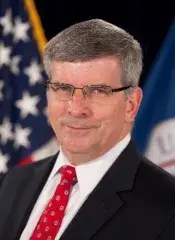Guest post by Dan Cotter, Executive Director, Office of Science and Engineering, Science and Technology Directorate

Last week, I had the awesome experience of leading a delegation to Hannover, Germany, for INTERSCHUTZ 2022, a world exhibition and discussion forum for fire and rescue, civil protection services, and safety and security. This was the ideal venue to share the Science and Technology Directorate’s (S&T) latest research and development (R&D) accomplishments and priorities with the international first responder community, an important stakeholder. INTERSCHUTZ allowed us to hold discussions with responders from all over the world about growing challenges for both the U.S. and global fire services, including the COVID-19 pandemic, and how we are leveraging cutting-edge technologies to face these challenges. Over the course of the week, we were also able to connect with government counterparts from Germany, Sweden, Israel, the Netherlands, Singapore, and Malaysia about their own R&D efforts and ways we can collaborate and innovate.
One of the efforts we highlighted at INTERSCHUTZ was the Virginia Smart Community Testbed (VA Testbed), a dynamic lab showcasing innovations developed to provide new solutions for homeland security and dual-use technologies—one of S&T’s most successful public-private partnerships to date. The idea for the VA Testbed was born more than three years ago, as S&T came together with the Virginia Innovation Partnership Corporation (VIPC), the Commonwealth of Virginia, and Stafford, Virginia, to convert a former convenience store into a cutting-edge testbed for technologies that can be applied to real-world uses benefitting the public.
Communication providers like Cisco and Verizon and a variety of private companies are utilizing the VA Testbed to explore new technologies, from WiFi-enabled “smart poles” to robotic lawnmowers. We featured three new testbed technologies at our INTERSCHUTZ exhibit booth:
- Fire Sensors: Two of S&T’s fire sensor prototypes are currently in use at the testbed. They offer air quality assessment, as well as fire ignition detection; when recently deployed for a test in Colorado, they picked up a fire ignition 36 minutes before the first 911 call, giving local authority significant advanced warning.
- Enterprise IoT Security: S&T is working with VIPC on protecting the security of IoT networks and sensors; this includes enterprise concepts for security management, secure production and onboarding on new devices and networks.
- In-Building Environmental Sensors: The in-building sensors, already put into use at Capitol One Arena in Washington, DC, have demonstrated proven benefits to public safety and venue operators by enhancing awareness of environmental threats in large venues.
In the future, the public-private partnership that has enabled the VA Testbed will expand its scope, opening hubs in Alaska, North Carolina, and 14 other locations across the U.S. I’m excited about the future possibilities that this partnership model opens up to us. We were also excited to use INTERSCHUTZ to launch Project Responder 6 (PR6), the latest iteration of our comprehensive study of emergency response capability needs across changes in the operating environment. The outcomes of this 430-page report will guide R&D and acquisition decisions for the response community for years to come. We presented an overview of the study and its participants, who come from a diversity of responder disciplines, roles, locations, and sizes of organization. The study identified high-priority responder needs in operational areas including situational awareness, communications and information sharing, responder health and safety, training and exercise, and much more.
Finally, we used our time in Germany to attend the annual meeting of the International Forum to Advance First Responder Innovation (IFAFRI), which was held in conjunction with INTERSCHUTZ 2022. IFAFRI is made up of government leaders from 15 countries and the European Commission and is focused on developing technologies to benefit first responders worldwide. Our participation in IFAFRI gives S&T a voice in influencing the global market to develop affordable solutions for first responders, to work with the international first responder community to define common capability gaps, and to collaborate on R&D to make first responders worldwide safer, more effective, and more efficient at their jobs. We were especially pleased to present the new PR6 report and our findings to our IFAFRI colleagues.
It was a jam-packed week for sure, and these were only a few of the highlights. The INTERSHUTZ and the IFAFRI meetings were a great opportunity not only for us to present what we’ve been up to for first responders, but to really listen to and learn from the civil protection and first responder communities around the world.
Some common threads across our conversations: there is an increased need for civil protection resulting from the impacts of security threats like climate change; the rising impacts of flooding and dangerous weather events, like tornadoes and extreme heat, are being felt by all our partners; and I was particularly surprised by the ubiquitous concern around wildland fire expressed by nearly everyone we spoke with.
Overall, there was a lot of excitement about what new technology can do to support our shared missions, increase our ability to work together through interoperable, standards-based architectures, and assure every new technology we jointly adapt has cybersecurity built in from the start. S&T has a great deal to contribute in mitigating these threats and hazards and we are going to go so much further with the help of our international partners.
Learn more about S&T’s First Responder Capability portfolio and our collaborations with international partners. For more information about our time at INTERSCHUTZ 2022, contact STMedia@hq.dhs.gov.
